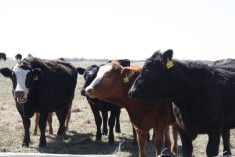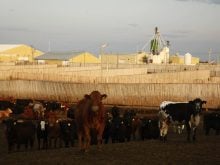This cattle market information is selected from the weekly report from Canfax, a division of the Canadian Cattlemen’s Association. More market information, analysis and statistics are available by becoming a Canfax subscriber by calling 403-275-5110 or at www.canfax.ca.
Fed market lower
The week’s cash offering was too small to establish price trends, but the general market tone for fed steers was around $1.50 per hundredweight lower.
Light dressed trade was reported midweek at $286 delivered, which was in line with the lower end of the previous week’s trade. Trade was at $290 later in the week.
Read Also

Flax sector sees omega-3 opportunity
SASKATOON — A global shortage of omega-3 oils could be an opportunity for the flax sector, says an industry official….
Delivery dates were four to five weeks out.
The cash-to-futures basis appeared to soften about $2, which put it modestly weaker than the long-term average.
Weekly western Canadian fed slaughter for the short holiday week ending Feb. 13 fell 13 percent to 23,818 head.
Weekly fed exports to Feb. 6 rose nine percent to 6,610 head. Exports are up 48 percent for the year.
Feedlots generally remain current. Forward pricing opportunities are improving, which could moderate the cash offering in coming weeks.
Cattle trade was sluggish in the United States with business developing only at the end of the week
Dressed sales in the northern U.S. were $3-$5 per cwt. higher with most trade at $208-$210.
Cow prices up
D1, D2 cows ranged $100-$114 to average $107.07, up 67 cents. D3 cows ranged $85-$104 to average $95.40.
Rail grade cows ranged $206-$211.
Western Canadian cow slaughter for the first two weeks of February was six percent larger than 2015. The bigger kills were accompanied by larger carcass weights at a record 823 pounds, which was 90 lb. larger than the same time last year.
The market is working through the tail end of the cows placed on feed in the fall.
Non-fed supplies should start to seasonally decline, but slaughter volumes will likely stay above year ago levels.
Feeders weak
Steers and heifers weighing more than 800 lb. traded $6-$8 lower and challenged the low prices of mid-December.
Over the past seven weeks, 850 lb. steer prices declined 13 percent, the largest drop of the past decade.
It was only early February when 850 lb. cash-to-futures basis levels were at a premium to the nearby feeder contract.
Basis levels are now weaker than the five year average.
Seasonally, more heifers should become ready for market.
Many producers marketed their steers last fall and seemed willing to carry females into 2016.
Producers are now culling herds and finalizing seed stock females.
However, heifer volumes ap-peared moderate over the past six weeks, and it’s surprising how many steers continue to come forward.
One-owner cattle that would normally be finished out, as well as some calves and light stockers that would traditionally be turned onto grass, are instead being sold on the cash market.
Bred cows sold at $1,700-$2,700, and bred heifers were $1,800-$3,025.
U.S. beef lower
U.S. Choice cutout was US$213.39, down $1.57, and Select was $209.27, down $3.03.
Beef demand remains sluggish, but reduced slaughter could support prices.
Canadian boxed beef prices for the week ending Feb. 6 traded mixed with AAA down C$10.36 per cwt. at $288.86 and AA up $1.02 at $288.04.
The AAA-AA spread sharply narrowed to 82 cents per cwt. from $12.20 the previous week.














